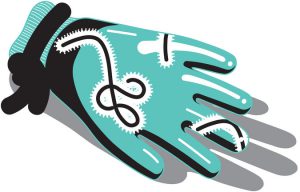MONROVIA, Liberia — LIBERIANS have begun calling the days between July 27 and Aug. 3 “the dark week” — 173 new Ebola virus cases and 94 new deaths. How much darker things may get is anybody’s guess.

In Johnsonville, a swampy town outside Monrovia, three dozen corpses in body bags were dumped in shallow holes marked by wooden headstones last week. Afterward, white gloves and other protective garments lay scattered everywhere — abandoned by a doctor and his burial team as the community, bewildered with fright, chased them away.
Meanwhile, in Monrovia, the government seemed overwhelmed and panic-stricken. Only on Wednesday did it declare a full state of emergency, letting the military quarantine large areas. Fear, misinformation and flat-out denial have been far too common since March, when West Africa’s Ebola outbreak reached Liberia. Among the government’s first reactions was to limit journalists’ coverage of it. That, in my view, is a major reason the virus has spread as fast as it has.
My first sight of an Ebola case came late in June, and only after I insisted that I be allowed to cover one of the many burials rumored to be taking place. When an assistant health minister finally said yes, I went to Paynesville, outside Monrovia, to the ELWA (Eternal Love Winning Africa) Hospital, where the aid workers included a physician, Kent Brantly, and a missionary, Nancy Writebol, the two Americans now back in the United States being treated themselves for Ebola.
As I entered the compound I saw men in white protective suits. One, who was to walk me through the burial ritual, whispered that he and his team were about to bring the body out. But a mourner told him, “My uncle did not have Ebola; he died from high blood pressure.” Confusion reigned until Dr. Brantly emerged and made it clear that the corpse being readied was not the Ebola victim’s. So the workers took off their protective suits, and the head of the burial team said it was too late to inter the Ebola victim: Neighbors of the burial site were chasing them away, fearing that the participants were contaminated.
The next day, I went back. It was a sad sight. Only three male relatives had come to mourn the victim, a man in his 20s. White-clad men brought out his body, zipped in a bag on a stretcher that they placed on the ground. An ambulance driver sprayed the bag, which another man in white then unzipped to let the relatives glimpse the corpse; one took a picture of it.
I was scared, so I filmed the burial from afar. FrontPageAfrica published my reporting and the images I took on our website and social media platforms.
Those were, I believe, the first images of the Ebola outbreak to circulate in Liberia, and the impact was huge; at last, people began to believe that this disease was real.
Officials say the outbreak seems to have spread to Liberia five months ago, when a woman from the rural north who had treated a sick relative traveled to Monrovia, where she vomited in a taxi and later died. The driver helped clean her up, coming into contact with the virus. The victim had also come into contact with her husband, her 2-year-old child, a motorcycle rider and others.
The next thing we knew, the number of cases, and of deaths, was swelling. They are now in the hundreds. But the government strictly warned journalists not to go near an Ebola case. “I beg you,” the health minister, Walter Gwenigale, warned us at a news conference, “don’t get contaminated by trying to do investigative reporting by going near people that may be sick. We will give you the information.”
But the effect was to quarantine information about the disease, rather than spread information about how people could protect themselves. For an early hint, we journalists had to turn to the United States Embassy’s April 4 advisory to American citizens, warning against contact with blood, body fluids or contaminated items.
In May, the rate of infection slackened but then rose again, prompting calls to close the borders with Guinea and Sierra Leone. The authorities refused, saying the economy would suffer. The craziest justification I heard was that the price of pepper would go up.
Ignorance ruled. Conspiracy theories sprouted that the government was faking the outbreak to draw foreign aid. Some Liberians, paralyzed by terror of the disease, stayed home rather than go to the hospital. Some kept to the ritual of bathing their dead; pastors laid hands on the sick. This only led to more deaths.
Then, on July 25, came news of the death, in Nigeria, of a Liberian-American government consultant who had traveled while showing symptoms of the disease. At last, I saw some seriousness from President Ellen Johnson Sirleaf about enforcing measures to contain the outbreak; she declared that the consultant, Patrick Sawyer, had knowingly put other countries at risk. She declared a national emergency, ordered schools closed and then raised the level of emergency to the equivalent of a state of war.
Such measures are welcome, but far too late. The Peace Corps is leaving Liberia. Airlines are cutting back service. We see no end to the outbreak.
Meanwhile, we watch the case of the two American aid workers, who have been flown out for intensive treatment. If it works, we can only hope the West will quickly share its methods with us in Africa, where the risk to the world is greatest.
Wade C. L. Williams is an investigative journalist at FrontPageAfrica.
A version of this op-ed appears in print on August 8, 2014, on page A23 of the New York edition with the headline: In the Grip of Ebola.
